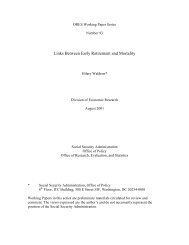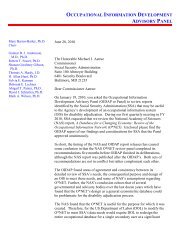Table 8.Estimated occupational distributions of unemployed SSI recipients, by occupational-choice model aOccupationSSI recipientsNon-SSI recipients with—No disability Any disability Work disabilityTotal 100.00 100.00 100.00 100.00Management, professional, and related 10.84 19.70 15.67 15.04Management 1.84 6.28 4.12 4.20Business and financial operations 1.48 2.65 1.82 1.75Computer and mathematical, architecture andengineering, life, physical and social science 0.25 2.79 2.17 1.92Community and social services 1.78 0.88 1.16 1.11Legal 0.37 0.52 0.45 0.47Education, training, and library 2.11 2.44 2.31 2.13Arts, design, entertainment, sports, and media 1.71 1.34 1.26 1.20Health-care practitioner and technical 1.31 2.80 2.38 2.25Service 34.33 22.73 29.21 30.01Health-care support 2.00 3.19 3.71 3.43Protective service 1.39 2.15 2.21 2.19Food preparation and serving related 9.82 8.25 10.23 10.21Building and grounds cleaning and maintenance 14.34 4.96 7.90 8.79Personal care and service 6.79 4.18 5.17 5.39Sales and office 23.51 27.28 24.67 24.34Sales and related 9.62 11.41 10.96 10.71Office and administrative support 13.88 15.87 13.71 13.62Farming, fishing, and forestry 1.00 0.74 0.81 0.75Construction, extraction, maintenance, and repair 4.54 12.15 10.71 10.37Production, transportation, and material moving 25.78 17.40 18.92 19.50Production 11.49 8.94 8.82 8.69Transportation and material moving 14.29 8.47 10.10 10.81SOURCE: Author's calculations using the 2007 American Community Survey.NOTES: The sum of individual categories may not equal the total because of rounding.a. The occupational-choice models are based on separate multinomial logit regressions of occupation for each population group.Covariates in all models include sex, ethnicity, race, marital status, education, age, and age squared. The disabled, work-disabled, andworking-SSI models also include disability type as additional covariates. All estimates use ACS balanced repeated replicate sampleweights. See Table A-3 for the results of the models.panel A). If currently unemployed or non-LFP SSIrecipients were placed in occupations according to theoccupational distribution of currently employed SSIrecipients, the difference between the groups wouldbe minimal. Only about 5 percent of the populationwould need to change occupations for parity (Table 10,panel B).About 16 percent of the population would have tochange occupations for unemployed SSI recipients andnonrecipients without a disability to reach occupationalparity; similarly, 17 percent of non-LFP SSI recipientsand nonrecipients without a disability would haveto change occupations. Surprisingly, the differencesbetween the distributions of unemployed recipients andnonrecipients with any disability or a work-related disabilityare slightly smaller than those between workingrecipients and unemployed recipients.DiscussionThere are several reasons why differences between theoccupational distributions of the groups do not disappearwhen controlling for observable demographiccharacteristics, human capital, and disability type.First, the working-age SSI population is composed oflow-income individuals with a disability defined to besevere and work limiting. It is unlikely that these individualsare physically, cognitively, or mentally capableof all the occupations available to the nondisabled or60 <strong>Social</strong> <strong>Security</strong> Bulletin • Vol. 69 • No. 3 • 2009
Table 9.Estimated occupational distributions of non–labor force participant SSI recipients, by occupationalchoicemodel aOccupationSSI recipientsNon-SSI recipients with—No disability Any disability Work disabilityTotal 100.00 100.00 100.00 100.00Management, professional, and related 10.16 18.58 14.44 14.56Management 1.54 6.64 4.03 4.16Business and financial operations 1.71 2.48 1.83 1.91Computer and mathematical, architecture andengineering, life, physical and social science 0.20 2.02 1.57 1.52Community and social services 1.26 0.83 1.03 1.08Legal 0.43 0.46 0.39 0.36Education, training, and library 2.41 2.29 1.99 1.93Arts, design, entertainment, sports, and media 1.34 1.10 1.04 1.14Health-care practitioner and technical 1.27 2.77 2.55 2.44Service 34.97 22.32 30.46 30.45Health-care support 2.70 3.36 4.01 3.74Protective service 1.38 1.77 2.17 2.16Food preparation and serving related 7.68 6.54 8.63 8.77Building and grounds cleaning and maintenance 14.77 6.25 9.71 9.78Personal care and service 8.44 4.40 5.95 6.00Sales and office 20.57 28.99 24.81 25.13Sales and related 8.02 10.90 10.03 10.33Office and administrative support 12.55 18.09 14.79 14.80Farming, fishing, and forestry 0.50 0.73 0.76 0.72Construction, extraction, maintenance, and repair 3.30 10.82 9.52 9.58Production, transportation, and material moving 30.50 18.56 20.01 19.57Production 14.98 9.93 9.71 9.53Transportation and material moving 15.52 8.63 10.30 10.04SOURCE: Author's calculations using the 2007 American Community Survey.NOTES: The sum of individual categories may not equal the total because of rounding.a. The occupational-choice models are based on separate multinomial logit regressions of occupation for each population group.Covariates in all models include sex, ethnicity, race, marital status, education, age, and age squared. The disabled, work-disabled, andworking-SSI models also include disability type as additional covariates. All estimates use ACS balanced repeated replicate sampleweights. See Table A-3 for the results of the models.disabled nonrecipient populations. For example, oneof the largest changes under the no-disability modelwould place almost 9 percent more individuals inconstruction occupations, which many SSI recipientssimply would not be able to do. Additionally,some recipients’ occupational choices may also beconstrained by an inability to work full time. Over70 percent of working SSI recipients work part time,compared with 17 percent of the population withouta disability (Table A-2). Section 1619(b) may ease thetransition from SSI to full-time employment, but itseffect is not clear.Second, SSI is a means-tested income supportprogram; therefore occupations that traditionallyhave high wages and salaries, such as most managementand professional occupations, will never havelarge numbers of SSI recipients. Workers in thoseoccupations typically earn more than an individualcan earn under SSI regulations while still receivingSSI payments. However, it is unlikely that many SSIrecipients would be able to obtain these occupationsgiven the average SSI recipient’s level of education andwork history.Third, the models, although similar to other modelsof occupational choice, are parsimonious and mostlikely suffer from some form of omitted variable(s)bias, which may bias the predictions. Similarly, manyobserved variables were not included in the model<strong>Social</strong> <strong>Security</strong> Bulletin • Vol. 69 • No. 3 • 2009 61
- Page 1 and 2:
Social SecuritySocial SecurityBulle
- Page 3:
Social SecurityBulletin Vol. 69, No
- Page 6 and 7:
Perspectives77 An Empirical Study o
- Page 8 and 9:
Selected Abbreviations—continuedM
- Page 10:
within the next few years (Aglira 2
- Page 14 and 15:
coverage varies significantly by ra
- Page 16 and 17: non-Hispanic white, and college edu
- Page 18 and 19: same groups (Table 6). For the last
- Page 20 and 21: from DB to DC pensions is accelerat
- Page 22 and 23: Table 8.Percent of individuals who
- Page 24 and 25: not necessarily the largest gains a
- Page 26 and 27: shoring-up DB plans before those pl
- Page 28 and 29: Table B-1.Percent change in mean pe
- Page 30 and 31: Table B-3.Percent of individuals wh
- Page 32 and 33: ReferencesAaronson, Stephanie, and
- Page 35 and 36: Social Security Administration’s
- Page 37: Chart 1.Historical expansion of Soc
- Page 40 and 41: self-employment information for the
- Page 42 and 43: (Cronin 1985). The final earnings r
- Page 44 and 45: prior to 1950, first year of earnin
- Page 46 and 47: average indexed monthly earnings (A
- Page 48 and 49: 13For an explanation of how the sel
- Page 50 and 51: Kopczuk, Emmanuel Saez, and Jae Son
- Page 53 and 54: Occupations of SSI Recipients Who W
- Page 55 and 56: on the differences between the occu
- Page 57 and 58: prediction models. Table A-1 lists
- Page 59 and 60: Occupational Distributions of theEm
- Page 61 and 62: similar, only 4 percent of the popu
- Page 63 and 64: Table 5.Estimated occupational dist
- Page 65: Table 7.Predicted Herfindahl-Hirsch
- Page 69 and 70: Table 11.Average annual wages of wo
- Page 71 and 72: Table A-2.Means and standard errors
- Page 73 and 74: Table A-3.Coefficients and standard
- Page 75 and 76: Table A-3.Coefficients and standard
- Page 77 and 78: Table A-3.Coefficients and standard
- Page 79 and 80: management, professional, and relat
- Page 81: Stapleton, David C., Nanette Goodma
- Page 84 and 85: Selected Abbreviations—continuedO
- Page 86 and 87: The 1983 Amendments to the Social S
- Page 88 and 89: Chart 1.Proportion of new claimants
- Page 90 and 91: Table 4.The evolution of the ARF an
- Page 92 and 93: for the test of equality of means b
- Page 94 and 95: Table 8.Average monthly Social Secu
- Page 96 and 97: in the chart, especially for men, t
- Page 98 and 99: 6This is a very important character
- Page 100 and 101: Benítez-Silva, Hugo, Berna Demiral
- Page 103 and 104: OASDI and SSI Snapshot andSSI Month
- Page 105 and 106: Monthly Statistical Snapshot, Augus
- Page 107 and 108: Table 2.Recipients, by eligibility
- Page 109 and 110: SSI Federally Administered Payments
- Page 111 and 112: Table 7.Average monthly payment, by
- Page 113: Awards of SSI Federally Administere
- Page 116 and 117:
Copyright—Authors are responsible
- Page 119 and 120:
Program Highlights, 2009Old-Age, Su








